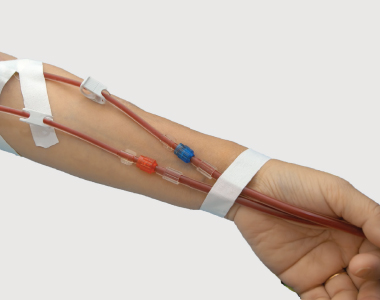Dialysis Fistuloplasty

Hemodialysis is a preferred treatment option for patients with chronic kidney disease. In this t procedure, the blood is filtered outside the body by a dialyzer or “artificial kidney”. For hemodialysis, a vascular access is created to insert the needles that connect the dialyzer, thereby allowing the blood to move out and return to the body at a high rate. An arteriovenous fistula is the preferred vascular access for hemodialysis.
An arteriovenous (AV) fistula is created by connecting an artery to a vein, usually in the wrist or upper arm. But sometimes, the fistula can become infected, blocked or narrowed. The blocked fistula can be treated by a balloon fistuloplasty.

What is balloon fistuloplasty?
Balloon fistuloplasty is a procedure in which any blockage or narrowing in the fistula is located by using a dye, and the blockage is relieved by stretching the blood vessels with a special balloon.
In this procedure, a small balloon is inflated for several times at the narrowed regions of a fistula; if required a stent may also be placed. This technique widens the lumen and facilitates the process of dialysis.
Why perform fistuloplasty?
A fistula can age and cause problems like clotting and scarring, thereby decreasing its function and effectiveness of dialysis. Clots can decrease the rate of blood flow or block the fistula completely. If these problems are left untreated, it may lead to the failure of fistula.
Thus, it is important to treat the narrowing or blockage at an early stage, so that the fistula works well, and dialysis occurs without any complications.
What are the risks of dialysis fistuloplasty?
Fistuloplasty is usually a safe procedure, but some complications may occur rarely. The common risks and complications associated with fistuloplasty include:
- Bruising around the site of insertion of the needle, which may become large and uncomfortable (rarely).
- Infection of large bruises, which may need antibiotic treatment or surgical intervention.
- Allergic reaction to the dye, which may present as a skin rash
- Circulatory problems due to the damage to the artery or fistula caused by catheter or balloon
- Treatment failure, which will require surgical intervention
How to prepare for the procedure?
Your healthcare provider will give you instructions to prepare for the procedure, which may include:
- You may be asked not to eat or drink anything for six hours before the procedure; you can drink water up to two hours before.
- Some blood tests may be performed before the procedure to evaluate the risk of bleeding.
- If you are diabetic, ask your doctor to alter the treatment regimen.
- Ask your doctor which medicines you can continue to take, and which ones you should stop.
- If you are taking any antiplatelets or anticoagulants, you may have to stop taking these medicines a few days before.
- Ensure that you have an adult to drive you home and accompany you overnight.
Inform your healthcare provider if you:
- Are allergic to iodine, or have any other allergies
- Have a history of reaction to the dye used for CT scan or X-rays
- May be or are pregnant
- Are a diabetic
What happens during the procedure?
The following are the steps usually performed in a fistuloplasty:
- You will be asked to lie on your back on an x-ray table. Some monitoring equipment will be attached to measure your heart rate and blood pressure.
- The interventional radiologist will observe the fistula by using an ultrasound, which provides a clear picture of the fistula.
- A small needle is inserted in the fistula, and a contrast dye is injected. This provides an image of the blood vessels, which helps to locate the narrowing or blockage.
- A catheter (a small, flexible tube) with a balloon at the tip is then inserted in the blood vessel to reach the precise location.
- Once the catheter reaches the site of the blockage or narrowing, the balloon is inflated and deflated several times from outside the body.
- Sometimes, if the balloon does not improve the fistula, a permanent stent may be used to widen the narrowing.
- Then the catheter is removed from the blood vessel, and the puncture site is stitched to prevent bleeding.
Usually, fistuloplasty takes about one hour, but the duration may vary in different patients.
What happens after the procedure?
You will have to stay in the hospital after the procedure for three to four hours for observation. Your pulse, blood pressure and oxygen levels in the body will be monitored regularly. You may return to your normal diet. The fistula is ready to use immediately after the procedure.
Your nurse will tell you when you can go home. You will need a friend or a family member to drive you home; using public transport is not recommended.
Your fistula should be ready for use immediately after the procedure.
What measures do I take after going home?
The following measures will help you recover better after a fistuloplasty:
- Rest well on the day of the procedure and the next day. Then, you can return to your normal activities.
- You can follow your normal diet.
- Take the pain killers as prescribed r instructed.
- Continue to take you regular medicines, as prescribed.
- Do not take metformin until two days after the procedure.
- You can have a bath or shower the next day.
Call your doctor immediately
if you have any of the following symptoms:
- A lot of swelling and bruising
- Severe pain at the puncture site that does not get better with painkillers
- Bleeding at the puncture site
- Change in the colour of your arm
- Fever or chills
- A lump, pus or discharge at the puncture site
- Difficulty breathing or chest pain


